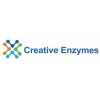Cat No.
NATE-0371
Description
Laccases are copper-containing oxidase enzymes that are found in many plants, fungi, and microorganisms. The copper is bound in several sites; Type 1, Type 2, and/or Type 3. The ensemble of types 2 and 3 copper is called a trinuclear cluster. Type 1 copper is available to action of solvents, such as water. It can be displaced by mercury, substituted by cobalt or removed via a copper complexone. Removal of type 1 copper causes a decrease in laccase activity. Cyanide can remove all copper from the enzyme however re-embedding with type 1 and type 2 copper has been shown to be impossible. Type 3 copper however can be embed back into the enzyme. Laccases act on phenols and similar molecules, performing a one-electron oxidations, which remain poorly defined. It is proposed that laccases play a role in the formation of lignin by promoting the oxidative coupling of monolignols, a family of naturally occurring phenols. Laccases can be polymeric, and the enzymatically active form can be a dimer or trimer. Other laccases, such as ones produced by the fungus Pleurotus ostreatus, play a role in the degradation of lignin, and can therefore be included in the broad category of ligninases.
Abbr
Laccase, Native (Coriolus versicolor)
Alias
Laccase
Species
Coriolus versicolor
Bio-activity
> 0.3 U/mg
Unit Definition
1 U corresponds to the amount of enzyme which oxidizes 1 μmol ABTS per minute at pH 4.5 and 25°C
Applications
Laccases (EC 1.10.3.2) are copper-containing oxidase enzymes that are found in many plants, fungi, and microorganisms. The copper is bound in several sites; Type 1, Type 2, and/or Type 3. The ensemble of types 2 and 3 copper is called a trinuclear cluster . Type 1 copper is available to action of solvents, such as water. It can be displaced by mercury, substituted by cobalt or removed via a copper complexone. Removal of type 1 copper causes a decrease in laccase activity. Cyanide can remove all copper from the enzyme however re-embedding with type 1 and type 2 copper has been shown to be impossible. Type 3 copper however can be embed back into the enzyme. Laccases act on phenols and similar molecules, performing a one-electron oxidations, which remain poorly defined. It is proposed that laccases play a role in the formation of lignin by promoting the oxidative coupling of monolignols, a family of naturally occurring phenols. Laccases can be polymeric, and the enzymatically active form can be a dimer or trimer. Other laccases, such as ones produced by the fungus Pleurotus ostreatus, play a role in the degradation of lignin, and can therefore be included in the broad category of ligninases. Because laccase belongs to the oxidase enzyme family it requires oxygen as a second substrate for the enzymatic action. Spectrophotometry can be used to detect laccases, using the substrates ABTS, syringaldazine, 2,6-dimethoxyphenol, and dimethyl-p-phenylenediamine. Activity can also be monitored with an oxygen sensor, as the oxidation of the substrate is paired with the reduction of oxygen to water. Laccase was first studied by Gabriel Bertrand in 1894 in Chinese lacquer tree sap, where it serves in the formation of lacquer (hence the name "laccase"). Laccase is able to catalyze ring cleavage of aromatic compounds.
Synonyms
Laccase; cross-linked enzyme aggregate; Laccase, Coriolus versicolor, CLEA; Laccase, Coriolus versicolor





